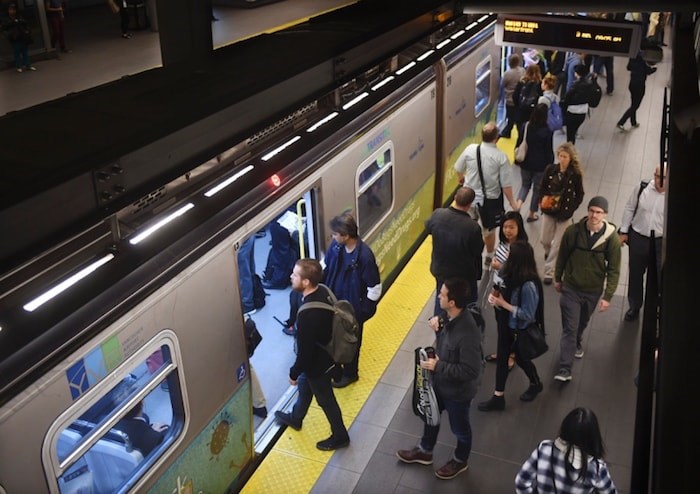The number of people in Vancouver using public transit on their daily commute is on the rise, and increasing faster than any other major metropolitan area in the country.
 The percentage of Vancouver residents using public transit to get to and from work has been steadily increasing over the last two decades. Photo Dan Toulgoet
The percentage of Vancouver residents using public transit to get to and from work has been steadily increasing over the last two decades. Photo Dan Toulgoet
According to census data released Wednesday, the proportion of people using public transit to get to and from work has been rising, slowly but steadily, over the last 20 years — Statistics Canada first starting collecting that information in 1996. That year, 10.1 per cent of Canadians commuted on public transit. In 2016, that number was 12.4 per cent. In terms of the actual number of commuters, there was an additional 734,350 public transit commuters over the last two decades — an increase of 59.5 per cent.
The data also shows the rate of people commuting on public transit is increasing at a faster rate than the overall number of commuters, which has increased by 30.3 per cent since 1996.
Vancouver ranks third in the nation, behind Toronto and Montreal, in terms of the proportion of workers using public transit. In 2016, 20.4 per cent of commuters in this city used public transit compared to 24.3 in Toronto and 22.3 per cent in Montreal. However, Vancouver saw a 6.1 per cent increase in the percentage of public transit commuters since 1996. Toronto and Montreal had increases of just 2.3 per cent and 2.5 per cent respectively.
According to Statistics Canada, part of the increased rate of use in the city is due to expansion of services in recent years. Between 2002 and 2009, Metro Vancouver saw two major expansions to the SkyTrain system, adding 53 additional kilometres of track, and 250 buses were added to the fleet between 2005 and 2009.
The number of people using “sustainable modes of transportation” is also on the rise. Statistics Canada defines this as “modes of transportation that have a smaller net impact on the environment or transportation infrastructure than cars and heavy trucks.” The census data includes the use of public transit, as well as active transportation (walking and cycling) and carpooling.
In 2016, nearly one third, 31.4 per cent, of employed Canadians regularly used a mode of sustainable transportation to get to work — with 12.4 per cent using public transit, 12.1 per cent carpooling and 6.9 per cent walking or cycling to work.
Amongst the country’s largest cities, Vancouver had the second highest proportion of commuters using a form sustainable transportation — 40.6 per cent compared to Toronto at 42.5 per cent. However, the city has the highest proportion of people walking or cycling to work — 9.1 per cent compared to 7.2 per cent in Montreal and 6.7 per cent in Toronto.
Travel times are also increasing, which is being attributed mostly to public transit. Between 2011, when Statistics Canada first started collecting data on travel times, and 2016 one-way commuting times went up by 0.8 minutes nationally from an average of 25.4 minutes to 26.2. For those using public transit, commuting time increased by 1.9 minutes to 44.8 minutes.
The average commuting time went up by more than a minute in both Vancouver and Toronto. However, Vancouver still has the shortest average commute of Canada’s three largest cities at 29.7 minutes compared to 30 minutes in Montreal and 34 minutes in Toronto.


